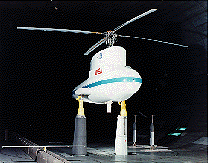INDIVIDUAL BLADE CONTROL PROJECT
 Two tests of an individual blade control (IBC) system for a full-scale helicopter rotor were performed; the first in 1993 and the second in 1994. Both test entries used a BO-105 helicopter rotor mounted to the Rotor Test Apparatus (RTA) in the NASA Ames 40- by 80-Foot Wind Tunnel. The standard blade pitch links of the rotor were replaced by servo-actuators so that the pitch of each blade could be controlled independently of the other blades. The specially designed servo-actuators and IBC control system were designed and manufactured by ZF Luftfahrttechnik, GmbH. The wind tunnel tests were an international collaborative effort between NASA/U.S. Army AFDD, ZF Luftfahrttechnik, EuroCopter Deutschland, and the German Aerospace Laboratory (DLR) and were conducted under the auspices of the U.S./German MOU on Rotorcraft Aeromechanics.
Two tests of an individual blade control (IBC) system for a full-scale helicopter rotor were performed; the first in 1993 and the second in 1994. Both test entries used a BO-105 helicopter rotor mounted to the Rotor Test Apparatus (RTA) in the NASA Ames 40- by 80-Foot Wind Tunnel. The standard blade pitch links of the rotor were replaced by servo-actuators so that the pitch of each blade could be controlled independently of the other blades. The specially designed servo-actuators and IBC control system were designed and manufactured by ZF Luftfahrttechnik, GmbH. The wind tunnel tests were an international collaborative effort between NASA/U.S. Army AFDD, ZF Luftfahrttechnik, EuroCopter Deutschland, and the German Aerospace Laboratory (DLR) and were conducted under the auspices of the U.S./German MOU on Rotorcraft Aeromechanics.
The objective of the investigations were to evaluate the potential of individual blade control to improve rotor performance, to reduce blade vortex interaction (BVI) noise, and to alleviate helicopter vibrations. The IBC control inputs tested were single-frequencies 2/rev - 6/rev, multi-harmonic combinations, pulses, wavelets, and doublet inputs. An extensive amount of measurement information was acquired for each IBC data point. These data include rotor performance data, average and time-varying hub loads data, rotor blade bending loads data, control system loads data, inboard and outboard blade pitch motion data, and BVI noise data. The data indicated that significant reductions in both BVI noise and hub vibrations could be obtained using IBC. The 2/rev IBC inputs produced the best single-frequency results. At the descent flight (terminal approach) condition, multi-harmonic IBC reduced the BVI noise by up to 11 dB while reducing the dominant 4/rev hub loads by up to 85 percent at the same time. The data also showed that performance improvements of up to 7 percent could be obtained using 2/rev input at high-speed forward flight conditions. In addition to several publications and reports, a complete record of the time history data and averaged Fourier spectrum of each channel is electronically available at the NASA Ames Research Center.
Related Publications:
Jacklin, S. A., Blaas, A., Teves, D., and Kube, R., "Reduction of Helicopter BVI Noise, Vibration, and Power Consumption Through Individual Blade Control", Proceedings of the 51st Annual Forum of the American Helicopter Society, May 1995.
Swanson, S. M., Jacklin, S. A., Blaas, A., Niesl, G., and Kube, R., "Acoustic Results from a Full-Scale Wind Tunnel Test Evaluating Individual Blade Control", Proceedings of the 51st Annual Forum of the American Helicopter Society, May 1995.
Swanson, S. M., Jacklin, S. A., Blaas, A., Kube, R., Niesl, G., "Individual Blade Control Effects on Blade-Vortex Interaction Noise", Proceedings of the 50th Annual Forum of the American Helicopter Society, May 1994.
Jacklin, S. A., Nguyen, K. Q., Blaas, A., and Richter, P., "Full-Scale Wind Tunnel Test of a Helicopter Individual Blade Control System", Proceedings of the 50th Annual Forum of the American Helicopter Society, May 1994.
Richter, P. and Blaas, A, "Full-Scale Wind Tunnel Investigation of an Individual Blade Control System for the BO-105 Hingeless Rotor", Proceedings of the Nineteenth European Rotorcraft Forum, Como, Italy, September 1993.
Jacklin, S. A., Leyland, J. L., and Blaas, A., "Full-Scale Wind Tunnel Investigation of a Helicopter Individual Blade Control System", Proceedings of the 34th AIAA/ASME/ASCE Structures, Structural Dynamics, and Materials Conference, April 1993.
Point of Contact:
Thomas Norman
NASA Ames Research Center
Moffett Field CA 94035-1000